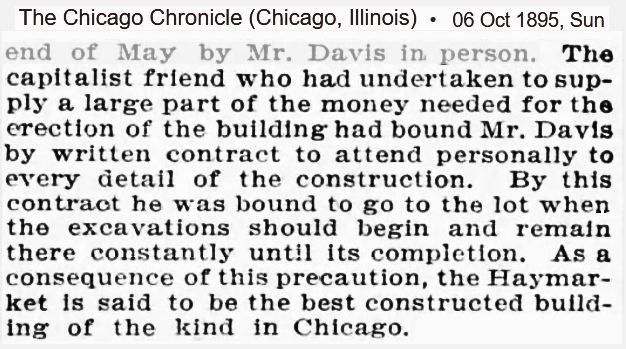|
In December 1893, ten years before the Iroquois fire, on a similarly bitter cold
day,
Will J. Davis' first theater burned. The Haymarket
caught fire at 10:00 am December 1, 1893, when a
blaze started in the fifth-floor space occupied by
the Monarch Textile company. Though it was a weekday
and there were stores and offices in operation,
everyone escaped, and there were no injuries.
Thousands turned out to watch the Chicago fire
department fight the blaze and when it was over,
Davis sent $150 to
fire chief Swenie for the firemen's pension fund
(around $4,000 in today's money) as appreciation for
the department's success in saving the structure.
|
 |
It was the first of three fires to theaters managed by Davis. Another would
come in 1900 with the Columbia
Theater. Davis no longer owned the Haymarket at
the time of the fire, having sold his interests to
Kohl & Castle in 1889, but served as the manager.
The five-story Haymarket structure remained
standing, but the interior was destroyed by fire and
water, representing a $100,000 loss. Contents of
stores and offices at the front of the building were
damaged, as well as the theater foyer. Other tenants
included the Giller Drug Company, Besinger
Cafeteria, and Asa Bertrand Segar's industrial
engineering company.
|
|
The Haymarket Theater was located on the north side
of Madison Street near Halstead, on Chicago's west
side. It was built new in 1887 with Davis'
direction, financed by circus giant
William Cole and
Al Hayman. It was near Chicago's infamous
Haymarket area but the name Hay in the name was
probably a nod to his other financial partner, Al
Hayman. Davis took the lease in May 1887. Cole is the "capitalist friend" referred to in newspaper clipping below.

The 120' x 187' structure was designed by Flanders
and Zimmerman. Built of St. Louis pressed brick, it
was trimmed in carved Portage brownstone with
polished granite columns and marble floors.
A forty-foot square grand salon, open to the floors
above, featured a water fountain.
The 70' x 90' auditorium included eight private
boxes and seating for 1,746, but a capacity of up to
3,000 people was asserted, so a full house would
have included 400 people standing on each floor of
the auditorium. The third-floor gallery offered
bench seating. The Haymarket had electric lighting
but also a gas lighting system in case of electric
failure. Davis boasted there were over 1,200 lamps —
provided by the same company that supplied the
Iroquois.
|

|
As he would do in the Iroquois Theater program, Davis
maintained that extra precautions were taken against
fire at the Haymarket. There were thirty-eight fire
escape exits that Davis claimed resulted in nearly
twice the lineal feet of exit space as any other
theater in Chicago. [Was there an alarm to the fire department, Will?]
The stage was 90' x 49' with a curtain opening of
38' x 36', seven miles of rigging, and a Georgia
pine floor.
The headliner dressing room was located at stage level and included a private
bath and sitting area. A dozen other dressing rooms
were in the basement and four above the stage. All
dressing rooms included sinks.
George A. Fair was treasurer and assistant manager at the Haymarket
when Davis managed the theater. (He also served as pallbearer when Will Davis' mother died in
1896.) Other officers in the Haymarket Theater Company: Walter T. Dwight, president, George W. Stanford, vice president, James F. Griffin,
secretary, and Herbert A. Beidler, treasurer.
The content of the program
produced for the premier of the Iroquois in 1903 was almost identical to that
for the Haymarket in 1887. Line art illustrations with
detailed credits for suppliers, all of whom Davis
probably arm wrestled to grant him a discount on
their goods and services in exchange for being
mentioned in the program.
Among those cited: Dainty
and Ward of the Marshall Field carpet and drapery
department, a Steinway piano from Lyon & Healy in
the grand salon, wood carvings by Steinmetz & Elenberger, a mantel by Healy & Millet, masonry work
by Victor Falkenau, plumbing by William McGraw, gas
and electric lighting by
T. W. Wilmarth ,ventilation by Ruttan
Manufacturing, steam boilers from F. W. Lamb & Co,
ornamental bronze and fountain from Winslow Bros.,
marble from K. M. Keating, plastering by Aug. Zander,
painting by Perkins Bros., fire escape stairs by
Globe Iron Works, copper cornices by Frank Kampe,
light plant by United States Electric Lighting,
cement paving beneath the theater by Portland Cement
Company, the stained glass used in private boxes by
McCully & Miles, beveled glass in the vestibule by
J. D. Roberts, perforated rubber matting from
Salisbury & Cline.
|
|
The grand opening was held December 24, 1887, with a
performance by Thomas W. Keene in his signature
Shakespearean role as King Richard III. Scenery was
produced by Noxon, Ernest Albert and Toomey, and
music was provided by the August Pellage Orchestra
In the program for the Haymarket's grand opening,
Davis attempted to draw a similarity between his
theater and the historic Haymarket in London but in
later years he attributed the theater name to its
close proximity to the Haymarket riots in Chicago.
|
 |
The program included an advertisement for song
sheets of tunes by a youthful-looking
Jessie Bartlett Davis.
Another advertiser,
Andrews Chairs, pictures folding auditorium seats with a hat clip. Andrews ran an advertisement in the Iroquois Theater premier program as well.
A second fire befell the Haymarket in 1904.
Davis was no longer involved with the theater by
then but if I had been an insurance underwriter
would have rejected any policy application from the
man. Fire followed him throughout his life.
|
